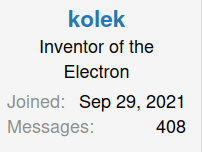You are using an out of date browser. It may not display this or other websites correctly.
You should upgrade or use an alternative browser.
You should upgrade or use an alternative browser.
What gauge wire for N-G bond?
- Thread starter kolek
- Start date
FilterGuy
Solar Engineering Consultant - EG4 and Consumers
What Wattage is the Inverter?
Quattrohead
Solar Wizard
Gonna be reading about another fire here one day.
Inverter manual and local code will tell you everything you need to know.
Inverter manual and local code will tell you everything you need to know.
Rednecktek
Solar Wizard
Usually whatever wire size it calls for your hot wires is the same size you need for your ground and neutral wires. I.E. if it wants 12awg wire for the AC, use 12awg for the ground.
ksmithaz1
Solar / EV Junkie
So,I have a jumper connecting load neutral to chassis in my inverter.
Maybe called a N-G bond? Not sure of the terminology.
Does this wire need to be a particular gauge to be effective?
Currently it's just a very thin 18AWG.

the "inventor of the electron" with 400+ posts is asking a blind question like this?
I'd say if it starts glowing red and it gets warm enough, a stick, some marshmallows, and hershey's mini's you can do smore's.
Real answers above. I think 18AWG is ~10A or so FTA/BUS.
kolek
Inventor of the Electron
- Joined
- Sep 29, 2021
- Messages
- 672
@FilterGuy Thanks for your response. Deye 8K inverter.What Wattage is the Inverter?
Well, there should be zero current on the n/g bond...
Unless there is a fault.
#4 solid is the max residential grounding conductor...
Unless there is a fault.
#4 solid is the max residential grounding conductor...
kolek
Inventor of the Electron
- Joined
- Sep 29, 2021
- Messages
- 672
That's right homie. Not only did I invent the electron, but I can turn off the electron at will, so it's best to stay on my good side!
hwy17
Anti-Solar Enthusiast
Mom said it's my turn to have the electron.
Anyway, is the 18 awg just a signaling wire for a bonding relay? If 18 awg came on the inverter I doubt it's supposed to be the bonding conductor itself. Who knows what they'll pass off though.
Anyway, is the 18 awg just a signaling wire for a bonding relay? If 18 awg came on the inverter I doubt it's supposed to be the bonding conductor itself. Who knows what they'll pass off though.
houseofancients
Solar Wizard
Depends if you use islanding mode.I have a jumper connecting load neutral to chassis in my inverter.
Maybe called a N-G bond? Not sure of the terminology.
Does this wire need to be a particular gauge to be effective?
Currently it's just a very thin 18AWG.
Manual stipulated the wire size to use with your inverter
Furthermore, that bond, if you are using a permanent bond, should be made in the breaker box and not your inverter.
Here that would be a very serious violation of code
kolek
Inventor of the Electron
- Joined
- Sep 29, 2021
- Messages
- 672
Guys I need to first see if/how the automatic N-G bonding function which @houseofancients introduced to me works in my inverter. If that is functional, this question is no longer relevant. I'll check back after I test that.
FilterGuy
Solar Engineering Consultant - EG4 and Consumers
So.... 8KW is 8000W/240V=33A. The jumper should be an 8AWG@FilterGuy Thanks for your response. Deye 8K inverter.
Similar threads
- Replies
- 17
- Views
- 376
- Replies
- 14
- Views
- 672


